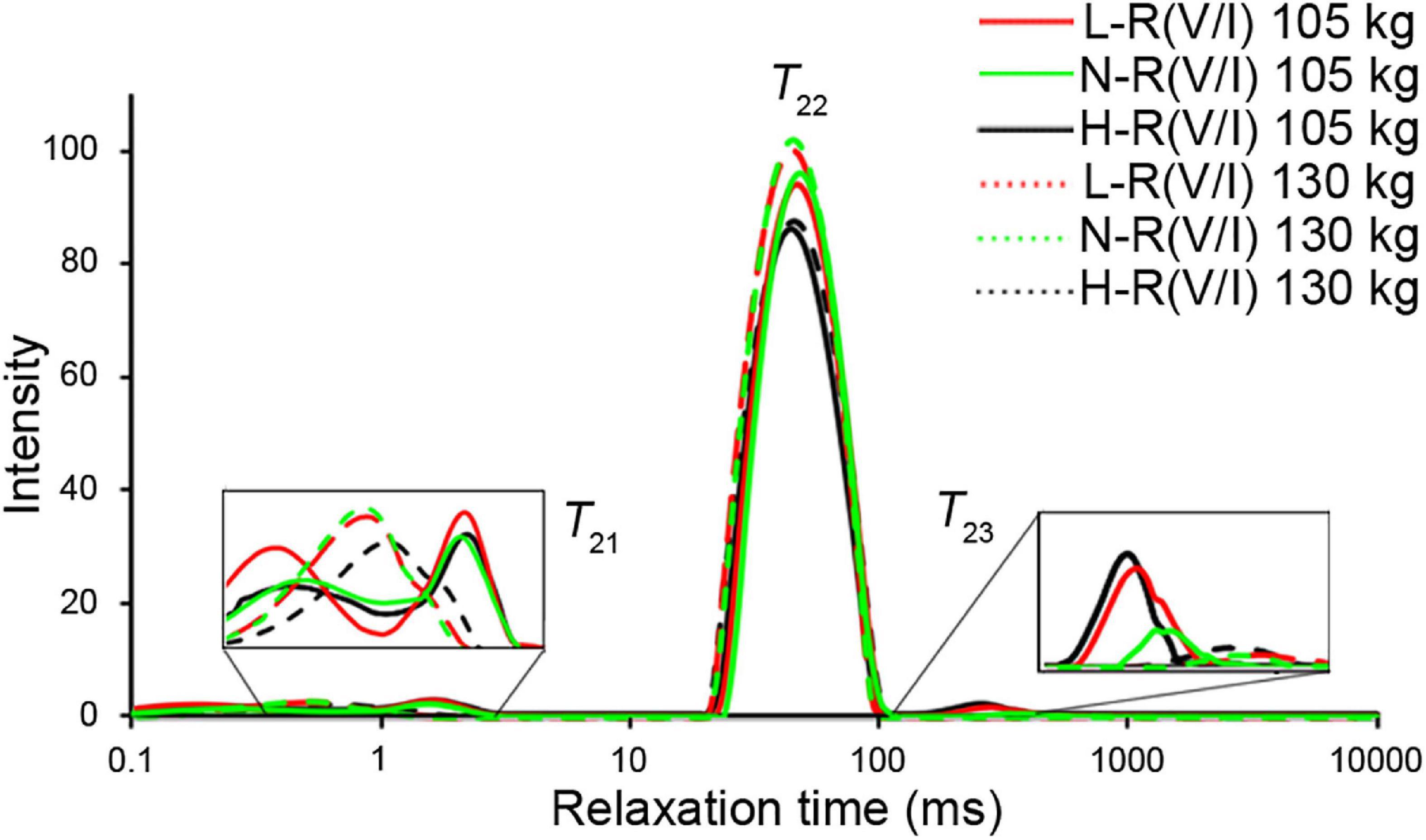- State Key Laboratory of Animal Nutrition, College of Animal Science and Technology, China Agricultural University, Beijing, China
The aim of this study was to investigate effects of dietary ratio of valine to isoleucine [R(V/I)] on carcass characteristics and meat quality of finishing pigs and whether slaughter weight influence the effect. We carried out a 2 × 3 factorial trial with two slaughter weight (105 vs. 130 kg) and three R(V/I) (0.58, 1.23, and 2.60 at 75–100 kg body weight, and 0.70, 1.24, and 2.39 at 100–135 kg body weight for L-, N- and H-R (V/I), respectively). Data show that increasing slaughter weight significantly increased meat color (a*45 min and b*45 min), drip loss and shear force (P < 0.05). Meanwhile, increasing slaughter weight reduced sarcomere length, the proportion of protein-bound water, and most kinds of muscular total amino acid contents except for tryptophan and arginine, while increased contents of muscular free lysine, tryptophan, leucine, isoleucine, valine, alanine, and arginine in the M. longissimus thoracis (P < 0.05). Health lipid indices based on fatty acid composition of intramuscular lipid were improved as the slaughter weight increased (P < 0.05). Notably, pigs received N-R (V/I) diet improved carcass traits in terms of thinner backfat thickness and higher fat-free lean index, as well as increased meat flavor-contributing amino acids at the cost of reduced intramuscular fat content and increased shear force of cooked meat compared with the pigs fed L-R (V/I) and H-R(V/I) diets (P < 0.05). H-R (V/I) diet decreased ultimate pH value and sarcomere length of the skeletal muscle but increased the proportion of free water (T23), consequently, increased drip loss and cooking loss of fresh meat in pigs (P < 0.05). In conclusion, both slaughter weight and dietary ratio of valine to isoleucine exerted significant impacts on carcass characteristics, meat quality and nutrition values. In particular, carcass traits and meat color of lighter pigs were more susceptible to the influence of dietary R (V/I) relative to heavier pigs.
Introduction
Branched-chain amino acids (BCAAs), including leucine, isoleucine and valine, play a vital role in skeletal muscle protein synthesis and metabolism. The amount of dietary leucine usually exceeds the requirement of pigs in commercial diets, while isoleucine and valine are regarded as limiting amino acids following lysine, methionine, threonine and tryptophan for obtaining optimal growth performance of pigs. The considerable wide range of BCAA combinations (1:0.25:0.25∼1:0.75:0.75, leucine:isoleucine:valine) has been reported to increase lipid accumulation in skeletal muscle and promote protein metabolism and muscle growth in growing pigs (1, 2). In our previous study, we found that dietary supplementation of extra isoleucine can enhance intramuscular fat accumulation and monounsaturated fatty acids (MUFA) synthesis in skeletal muscle through depressing the phosphorylation of AMPKα-ACC and stimulating the expression and activity of SCD in finishing pigs (3). Furthermore, we found the coordination existed between dietary valine and isoleucine on backfat thickness and water holding capacity of fresh meat in finishing pigs (4). Therefore, we supposed that the dietary ratio of valine to isoleucine [R(V/I)] might impose a significant impact on carcass characteristics and meat quality in finishing pigs.
The compositions of muscular free amino acids and fatty acids are of great interest in meat industry since they are important for meat edible quality (5, 6). We speculate that BCAA especially isoleucine and valine might be involved in the regulation of amino acid and fatty acid profiles of fresh meat as they promote protein synthesis and intramuscular fat (IMF) formation (3, 7).
Besides, slaughter weight is an important factor determining the economic profitability of pork production. Presently, pig slaughter weight especially in China trends to increase from 110 kg to more than 130 kg in order to reduce production costs and earn more margin profit (8). However, some studies have shown disadvantages caused by increased slaughter weight, such as reduced feed conversion efficiency, excessive backfat thickness and decreased lean rate of pigs (9, 10).
The effect of dietary nutrient level on carcass characteristics and meat quality may be influenced by slaughter weight (11). However, there are few studies concerning effects of dietary BCAA on carcass characteristics and meat quality and nutrition values between different slaughter weights of finishing pigs. Therefore, the objective of this experiment was to test the interactive effects, if any, of dietary R(V/I) and slaughter weight on the fatty acid profile and free amino acid composition of fresh meat in finishing pigs.
Together, given economic benefit in the swine industry, the nutrition and eating quality of meat, we aimed to explore the effects of dietary ratio of valine to isoleucine [R(V/I)] on carcass characteristics and meat quality of finishing pigs and whether slaughter weight influence the effect.
Materials and Methods
Ethics Statement
All procedures conducted in the present study were approved by the Institutional Animal Care and Use Committee of China Agriculture University (ID: SKLAB-B-2010-003).
Experiment Design, Animals and Experimental Diets
Fifty-four crossbred castrated male pigs (Duroc × Landrace × Yorkshire) with an initial body weight of 74.1 ± 1.3 kg were allocated into three dietary treatments in a randomized complete block design based on the initial body weight (BW), with six replicates (pens) per treatment and three piglets per pen. All the pigs were housed in pens (1.8 × 2.1 m2) with 50% of slatted floors in an environmentally controlled room in FengNing Swine Research Unit of China Agricultural University (Academician Workstation in Chengdejiuyun Agricultural and Livestock Co., Ltd., Fengning County, Hebei Province, China).
The experimental diets were formulated to be isoenergetic and to meet the nutritional requirements for pigs of 75–100 kg and 100–135 kg BW (12), respectively. Experimental diets were formulated to be equivalent in the amounts of standard ileal digestible (SID) essential AA except for isoleucine and valine. The levels of isoleucine and valine were formulated according to experiment design. The composition and nutrient levels of the experimental diets are shown in Table 1. At the beginning, pigs were fed with diets of 75–100 kg BW. The three experimental diets were formulated with R (V/I) as follows: L-R (V/I) = 0.58, (SID valine = 0.31%, SID isoleucine = 0.53%); N-R (V/I) = 1.23, (SID valine = 0.48%, SID isoleucine = 0.39%); H-R (V/I) = 2.60, (SID valine = 0.65%, SID isoleucine = 0.25%). While the average BW of pigs exceeded 100 kg (actual 104.41 kg), pigs close the average BW of pen were selected to be humanly slaughtered (n = 6). The remaining 36 pigs shift to diets for 100–135 kg BW (Table 1) until BW approached 130 kg (actual 131.52 kg). The R (V/I) of the three dietary treatments were formulated as follows: L-R (V/I) = 0.70 (SID valine = 0.31%, SID isoleucine = 0.44%), N-R (V/I) = 1.24 (SID valine = 0.41%, SID isoleucine = 0.33%), H-R (V/I) = 2.39 (SID valine = 0.55%, SID isoleucine = 0.23%). During feeding trials, pigs had ad libitum access to the diets and clean drinking-water for 63 days. At the end of experiment, one pig from each pen was humanly slaughtered. The pigs slaughtered at two stages were subjected to assessment of carcass characteristics and meat quality as well as meat nutritional composition.
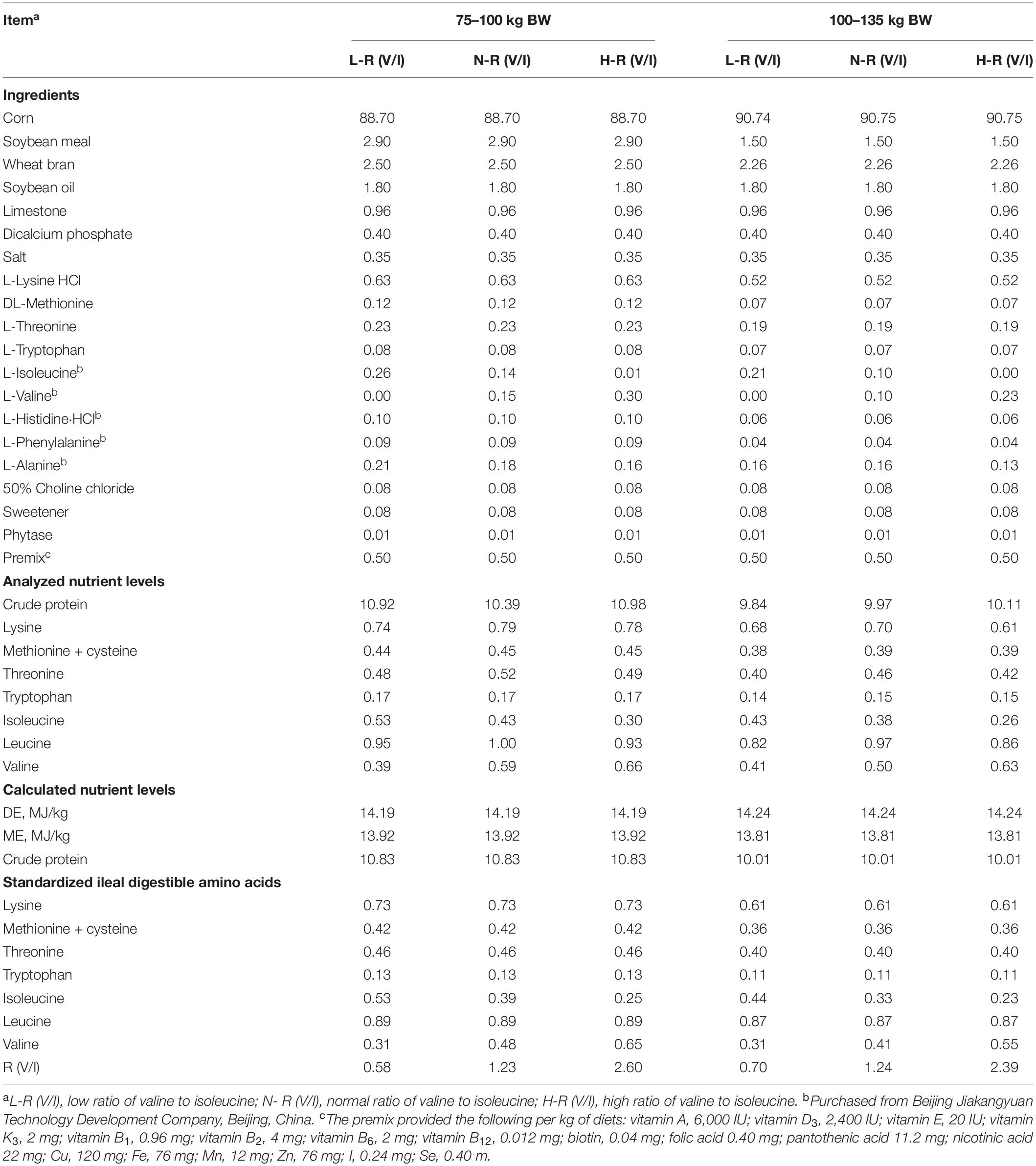
Table 1. The composition and nutrient content of the experimental diets provided for finishing pigs (%)a.
Sample Collection
Before the slaughter, blood samples were collected from the precaval vein of pigs close to the average BW of each pen (n = 6) after overnight starvation for 16 h. Serum was separated and stored at −20°C for further analysis. Pigs were transported to local abattoir. After rest at least 4 h, the pigs were electrically stunned, exsanguinated and eviscerated according to the standard commercial procedure. Moreover, at 30 min postmortem, chops of the M. longissimus thoracis from the 10th to 12th ribs of each left carcass were separated and trimmed off extra-muscular fat and connective tissues. After the determination of meat color and pH at 45 min (pH45 min), these chops were vacuum-packed at 4°C to measure subsequently meat quality, including muscle pH at 24 h (pH24 h), drip loss, cooking loss and shear force as well as NMR transverse relaxation (T2) measurement. About 100 g of chops were stored at –20°C for measurement of contents of moisture, crude protein and IMF, as well as amino acid and fatty acid composition. For myofibril ultrastructure examination, the M. longissimus thoracis between the 9th and 10th rib was cut to 1 mm3 and stored immediately in fixing solution (2.5% glutaraldehyde phosphate buffer saline, pH 7.2).
Carcass and Meat Quality Evaluation
Dressing percentage was calculated by dividing the hot carcass weight by slaughter weight. Backfat depth at the thickest shoulder, last rib, 6th to 7th rib, 10th rib, and the last lumbar vertebra were recorded. Fat-free lean index = 50.767 + [0.035 × hot carcass weight (Ib)] – [8.979 × the last rib fat thickness (in.)] (NPPC, 1994) (13). Loin eye area (cm2) = loin eye height (cm) × width (cm) × 0.7).
At 45 min postmortem, meat color (L*, a*, b*) was measured with a Minolta Chroma Meter (Minolta Chroma Meter Measuring Head CR-410 Minolta, Osaka, Japan), pH45 min value was measured with a SPK pH meter (pH-star, DK2730, Herlev, Denmark). Meanwhile, the pH24 h value was determined at 24 h postmortem in 4°C chilling room.
Drip loss was determined by a suspension method and calculated as follows: drip loss (%) = [(initial weight-final weight)/initial weight] × 100. The pork cooking loss and shear force was measured. Briefly, the M. longissimus thoracis chops were cooked to an internal temperature of 70°C for 30 min in 75°C thermostatic water bath. Chops were allowed to cool to room temperature, wiped with absorbent paper to remove residual moisture and reweighed to calculate cooking loss. Then the cooked chops were cut to 1 × 1 × 3 cm2 parallel to the muscle fiber orientation to measure the tenderness using a digital-display muscle tenderness meter (C- LM3B, Tenova, Harbin, China). Twelve replicates of each sample were measured.
Samples of the M. longissimus thoracis were cut into 2–3 mm thin slices and freeze-dried using vacuum frozen dryer (Freezone 4.5™, Labconco Corp., Kansas City, MO, United States) and ground into powder for analysis of crude protein, IMF, fatty acid and amino acid. The IMF content was analyzed by Soxhlet petroleum-ether extraction. The crude protein content was measured according to Association of Analytical Chemists methods (14).
Nuclear Magnetic Resonance Transverse Relaxation (T2) Measurement
Low field NMR transverse relaxation was measured as described previously (4). Briefly, approximately 3 g of meat from the center of each sample were analyzed using a Niumag Pulsed NMR analyzer (PQ001, Niumag Corporation, Shanghai, China) operating at a resonance frequency for protons of 23 MHz at 32°C (15, 16). Three forms of water distribution in fresh meat including protein-bound water (a minor component between 1 and 10 ms, T21), immobilized water (a major component between 30 and 100 ms, T22) and free water (a much weaker component between 100 and 500 ms, T23).
Myofibril Ultrastructure
As previously described (17), 2.5% glutaraldehyde-fixed isolated myofibrils were fixed with 1% osmium tetroxide (OsO4) for 2 h, and then dehydrated with ethanol gradient, followed by embedded with resin. After set in a 60°C incubator for 48 h, the solidified tissue was made into an ultrathin section, and then subjected to double electron staining of uranyl acetate-lead citrate. After washing with water, myofibril ultrastructure was observed under a transmission electron microscope (H-7500, HITACH Corporation, Japan), and sarcomere length, the distances between Z lines, representing a measure of muscle contraction was measured.
The Compositions of Amino Acids and Fatty Acids in Fresh Meat
The free amino acid concentration in the M. longissimus thoracis was analyzed using ultra high-performance liquid chromatograph (Waters ACQUITY UPLC I-Class, Waters, United States) and high-resolution mass spectrometer (Q-Exactive, Thermo Fisher, United States) as previously described (18). About 300 mg muscle sample were dissolved in water with methanol (water: methanol = 2:8, v/v). After ultrasonic treatment for 5 min, the sample was placed at room temperature for 1 min, and the above operation was repeated for six times. The sample was then placed on ice for 2 h and centrifuged at 10,000 g, 4°C for 10 min to collect the supernatant.
Total amino acid (mainly protein-bound amino acids) profile of the M. longissimus thoracis was determined based on the standard methods in AOAC (14).
The composition of fatty acids of the M. longissimus thoracis was analyzed as described previously (19). About 150 mg lyophilized muscle sample was added with 4 ml chloracetyl methanol (1:10, v/v), 1 mL n-hexane and 1 mL internal standard FA solution (1 mg/mL C11:0). The mixture was then kept in a water bath at 75°C for 2 h. After cooling to room temperature, the mixture was added with 5 mL carbonate solution (70 g/L) and centrifuged at 800 g for 3 min. The supernatant was analyzed by the Gas Chromatography (HP 6890 series, Hewlett Packard, Avondale, PA, United States).
Lipid Health Quality Indexes
The health quality of the lipid components of muscle was assessed by calculating: (1) the index of atherogenicity (IA), (2) the index of thrombogenicity (IT), and (3) the ratio between the hypocholesterolemic and hypercholesterolemic fatty acids (HH).
The index of atherogenicity (IA) indicates the relationship between the sum of the main saturated fatty acids and that of the main classes of unsaturated ones. Saturated fatty acids are considered pro-atherogenic (favoring the adhesion of lipids to cells of the immune and circulatory system). However, unsaturated fatty acids are qualified as anti-atherogenic (inhibiting the aggregation of plaque and diminishing the levels of esterified fatty acid, cholesterol, and phospholipids, thereby preventing the appearance of micro- and macro-coronary diseases).
The index of thrombogenicity (IT), defined as the ratio of the pro-thrombogenetic (saturated) to the anti-thrombogenetic (unsaturated) fatty acids, shows the tendency to form clots in the blood vessels.
The following equations were used to calculate these indexes:
- Atherogenic Index (20)
- Thrombogenic Index (20)
- Ratio between hypocholesterolemic and hypercholesterolemic fatty acids (21)
where Σ = Summatory, MUFA = monounsaturated fatty acids, and PUFA = polyunsaturated fatty acids.
Statistical Analyses
Data were analyzed using the mixed procedure SAS 9.2 (SAS Institute Inc., Cary, NC, United States) following a completely randomized design according to a 3 (R(V/I)) × 2 (slaughter weights) factorial arrangement with individual pig as the experimental unit. The statistical model included the fixed effects of the R(V/I), slaughter weight and their interaction and the pig as random effect of the experiment. When P-value for interaction terms was above 0.05, the interaction was excluded from the statistical model. If the interaction was significant, Tukey’s test was used to compare treatment means within a slaughter weight. Differences were considered significant when P < 0.05.
Results
Carcass Traits
As shown in Table 2, carcass weight and loin eye area of pigs were not altered by the dietary R (V/I). Pigs slaughtered at 130 kg BW had thicker backfat thickness compared with pigs slaughtered at 105 kg BW (P < 0.05). Pigs offered N-R (V/I) diet had the thinnest backfat thickness at the shoulder, last rib, and highest fat-free lean index among all pigs slaughtered at 105 kg BW (P < 0.05). In contrast, no effect of R (V/I) on the last rib fat thickness and fat-free lean index was observed in pigs slaughtered at 130 kg BW. Significant interactions existed between R (V/I) and slaughter weight on the last rib fat thickness and fat-free lean index.
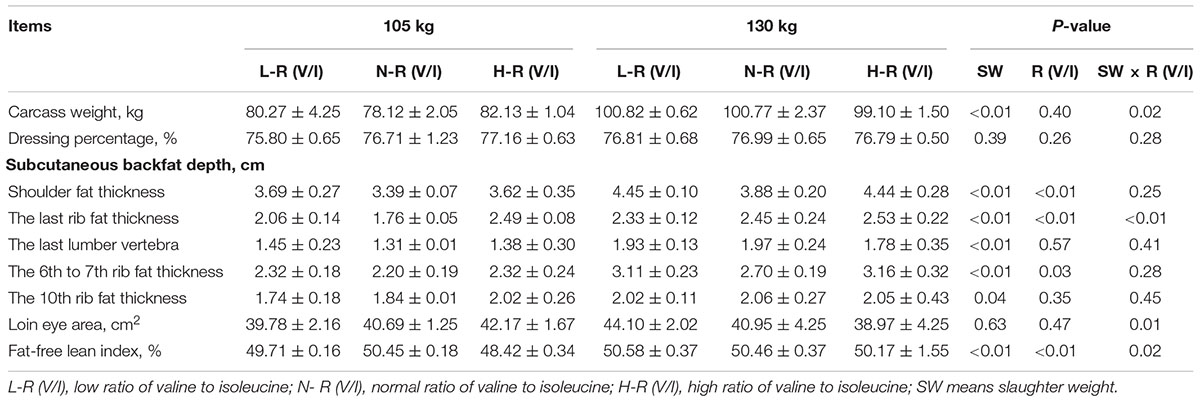
Table 2. Effect of dietary R (V/I) and slaughter weight on the carcass traits in finishing pigs (n = 6).
Meat Quality
As shown in Table 3, with the slaughter weight increased, meat quality in terms of a*45 min (P = 0.03), b*45 min, pH24 h value, shear force, marbling score and drip loss as well as intramuscular fat content significantly increased (P < 0.01), while crude protein level decreased (P < 0.01). Dietary R (V/I) significantly affected most indices of meat quality, especially in N-R (V/L) treatment, shear force (P = 0.02) was the highest while intramuscular fat content (P = 0.05) was the lowest among dietary treatments. Additionally, significant interaction between slaughter weight and dietary R (V/I) was observed on pH values (P < 0.01), a*45 min (P = 0.03) and marbling score (P = 0.02).
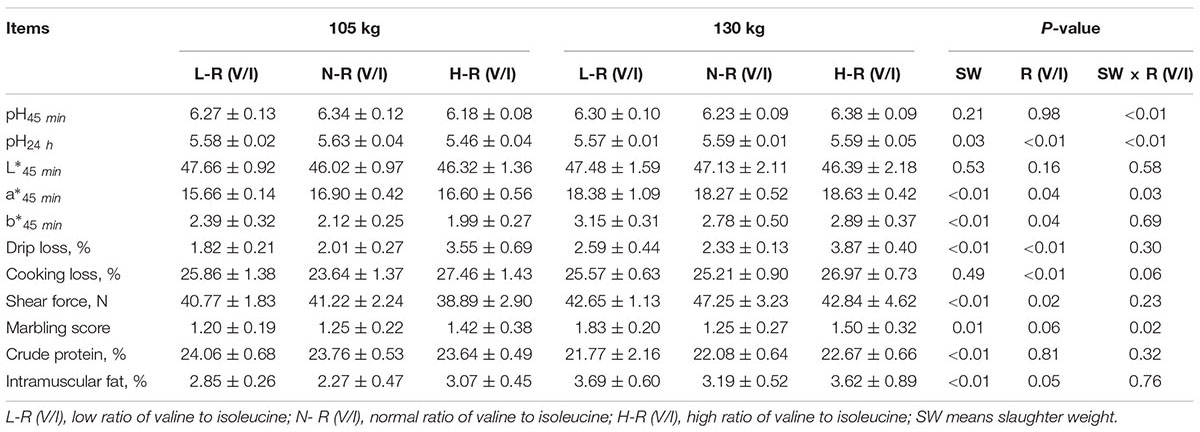
Table 3. Effect of dietary R (V/I) and slaughter weight on the meat quality and proximate analysis of longissimus dorsi in finishing pigs (n = 6).
Nuclear Magnetic Resonance Transverse Relaxation (T2)
As shown in Table 4 and Figure 1, the proportions of bound water (T21) and free water (T23) decreased with the slaughter weight increased, while the proportion of immobilized water (T22) increased (P < 0.01). Pigs fed with L-R (V/I) diets had the highest proportion of bound water and pigs fed with H-R (V/I) diets had the highest proportion of free water, while pigs fed N-R (V/L) had the lowest proportion of free water and highest proportion of immobilized water (P < 0.01). The significant interaction between slaughter weight and R (V/I) was found on the proportions of bound water (P = 0.02) and immobilized water distribution (P = 0.03).

Table 4. Effect of dietary R (V/I) and slaughter weight on the T2 peak area ratio of longissimus dorsi in finishing pigs (n = 6).
Myofibril Ultrastructure
The myofibril ultrastructure was shown in Figure 2. With slaughter weight increased, the M line located on the center of the A band looked vaguer, and the sarcomere length decreased (P < 0.01). The myofibrils of pigs fed with L-R(V/I) diet were tightly integrated with visible I and A band, and the Z lines, actin and myosin could be distinguished. However, the most decayed myofibrils structure could be found in the M. longissimus thoracis of pigs fed H-R(V/I) diet, in which myofibrils gradually fractured along the Z line. What’s more, along with dietary R (V/I) increased, the sarcomere length decreased in pigs slaughtered at 105 kg body weight, but no effect observed in pigs slaughtered at 130 kg body weight.
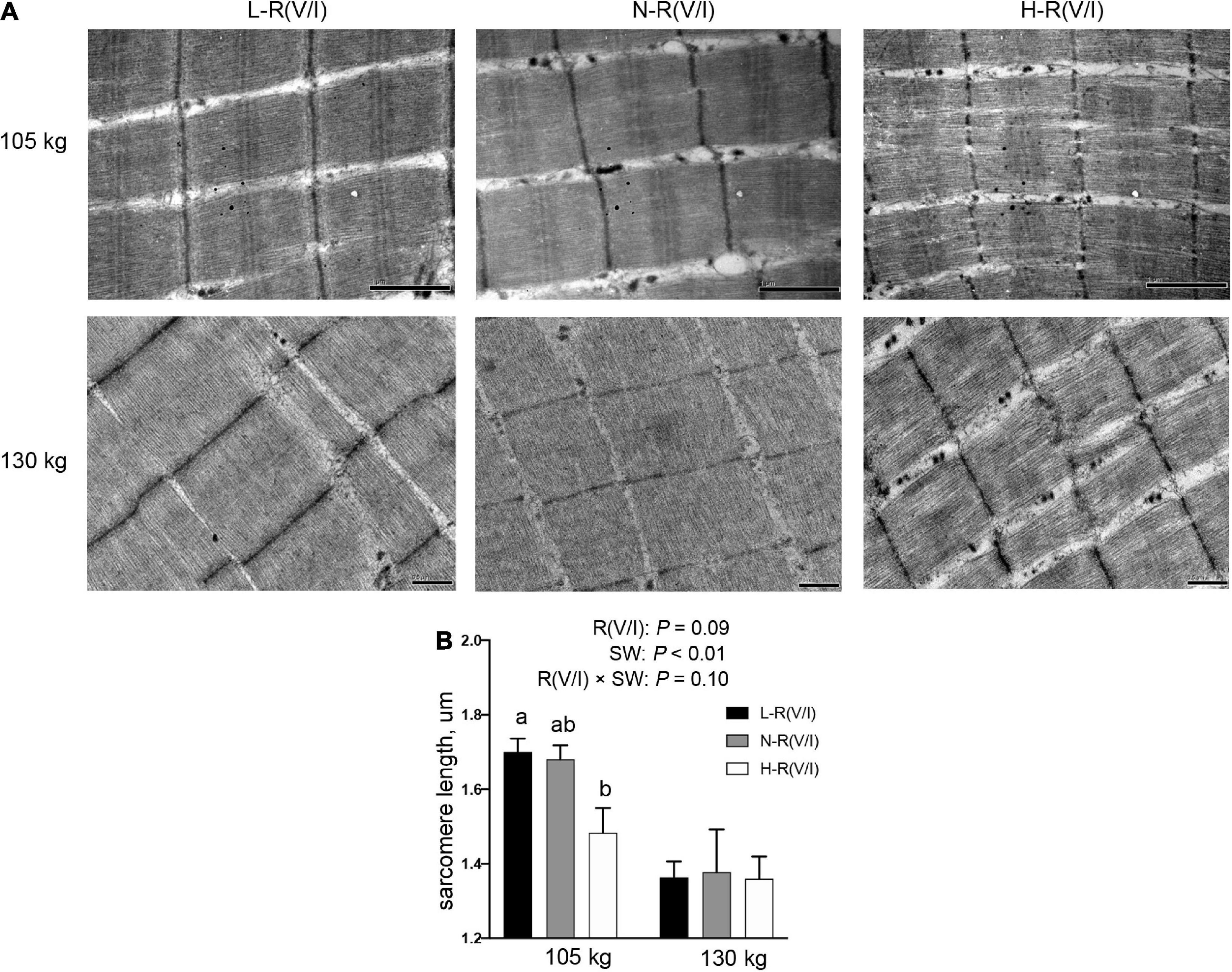
Figure 2. Effects of dietary R (V/I) and slaughter weight on the ultrastructure of the M. longissimus thoracis in finishing pigs. (A) The ultrastructure of longissimus dorsi from pigs treated with diet with three R (V/I) and slaughtered at 105 or 130 kg body weight. (B) Sarcomere length of the M. longissimus thoracis. Transmission electron microscopy images at original magnifications of × 30,000. Different letters represent significant differences among the groups (P < 0.05), n = 6.
Muscular Free Amino Acid and Total Amino Acid Profile
Muscular free amino acid profile was presented in Table 5. With slaughter weight increased, the amounts of muscular free lysine, tryptophan (P = 0.03), leucine, isoleucine, valine, alanine, arginine, and bitter amino acid were significantly increased (P < 0.01), while methionine, asparagic acid and glycine were decreased (P < 0.01). Besides, the amounts of muscular free phenylalanine, leucine, valine, alanine, asparagic acid and glutamic acid, glycine were significantly altered by dietary R (V/I) treatments (P < 0.05). Highest amounts of umami and sweet amino acid were observed in pigs fed N-R (V/I) diet compared with those in pigs fed H-R (V/I) and L-R (V/I) diet (P < 0.05). The significant interactions were observed between slaughter weight and dietary R (V/I) on muscular free methionine, phenylalanine, tryptophan, leucine, isoleucine, asparagic acid, proline, tyrosine and bitter amino acid (P < 0.05). The effects of dietary R (V/I) on these muscular free amino acids depended on the slaughter weight.
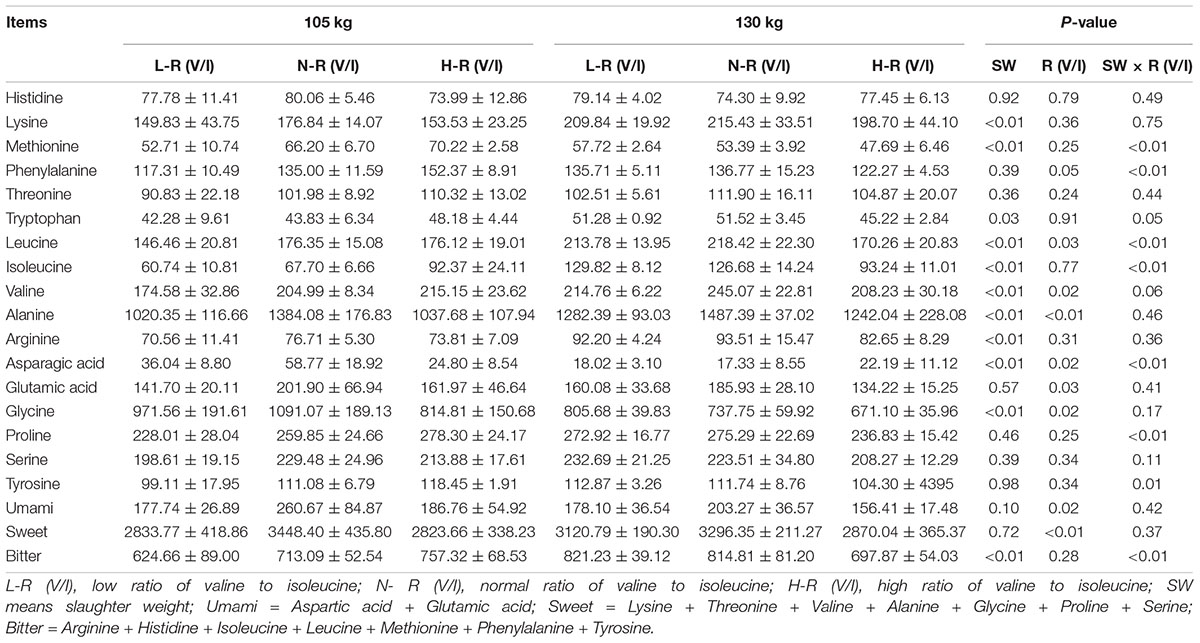
Table 5. Effect of dietary R (V/I) and slaughter weight on muscular free amino acid concentration in finishing pigs (nmol/g, n = 6).
We determined amounts of protein-bound amino acids of fresh meat. Interestingly, we found that muscular contents of most protein-bound amino acids except tryptophan and arginine significantly decreased with the slaughter weight increased (P < 0.01) (Table 6). H-R (V/I) dietary treatment significantly decreased the content of lysine, methionine, threonine, alanine, asparagic acid, cysteine, glycine and serine compared with N-R (V/I) treatment (P < 0.05). There was no interaction between diet R (V/I) and slaughter weight.
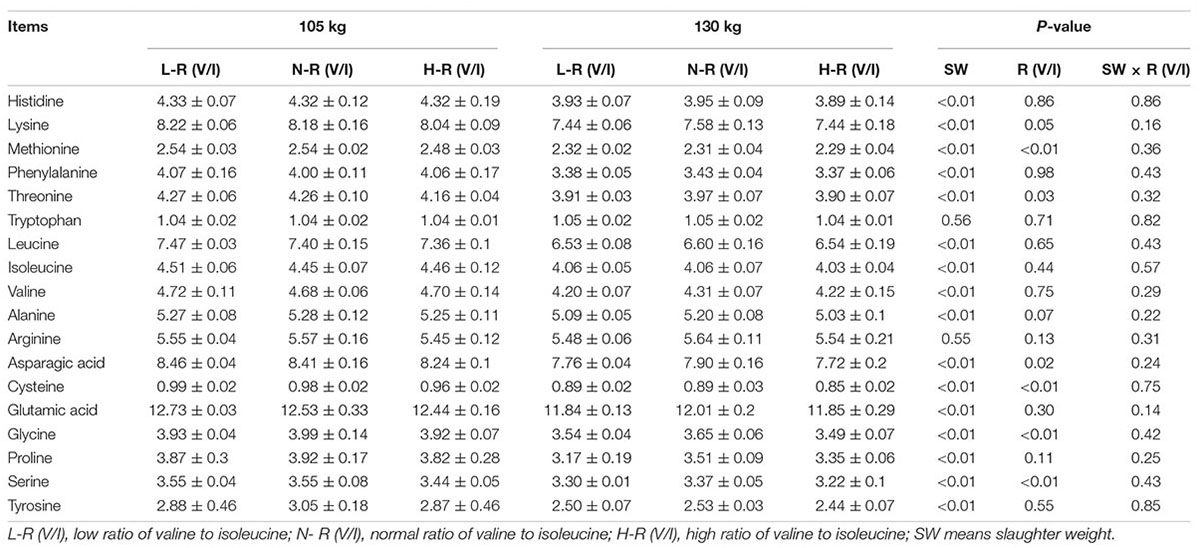
Table 6. Effect of dietary R (V/I) and slaughter weight on total amino acid concentration of fresh meat in finishing pigs (% of freeze-drid meat, n = 6).
Composition of Fatty Acid in the Longissimus Dorsi Muscle
Compared with pigs slaughtered at 105 kg, pigs slaughtered at 130 kg BW had higher total fatty acids, HH and composition of C14:0, C16:0, C16:1, C18:1n9c and MUFA, but lower IT, PUFA/SFA and composition of C14:1, C15:0, C17:0, C18:2n6c, C18:3n3, C21:0, C20:3n6, C20:4n6, C20:3n3, C20:5n3, C22:0, C24:0, C22:6n3, C24:1, PUFA, 6-PUFA, and 3-PUFA (P < 0.01) (Table 7).
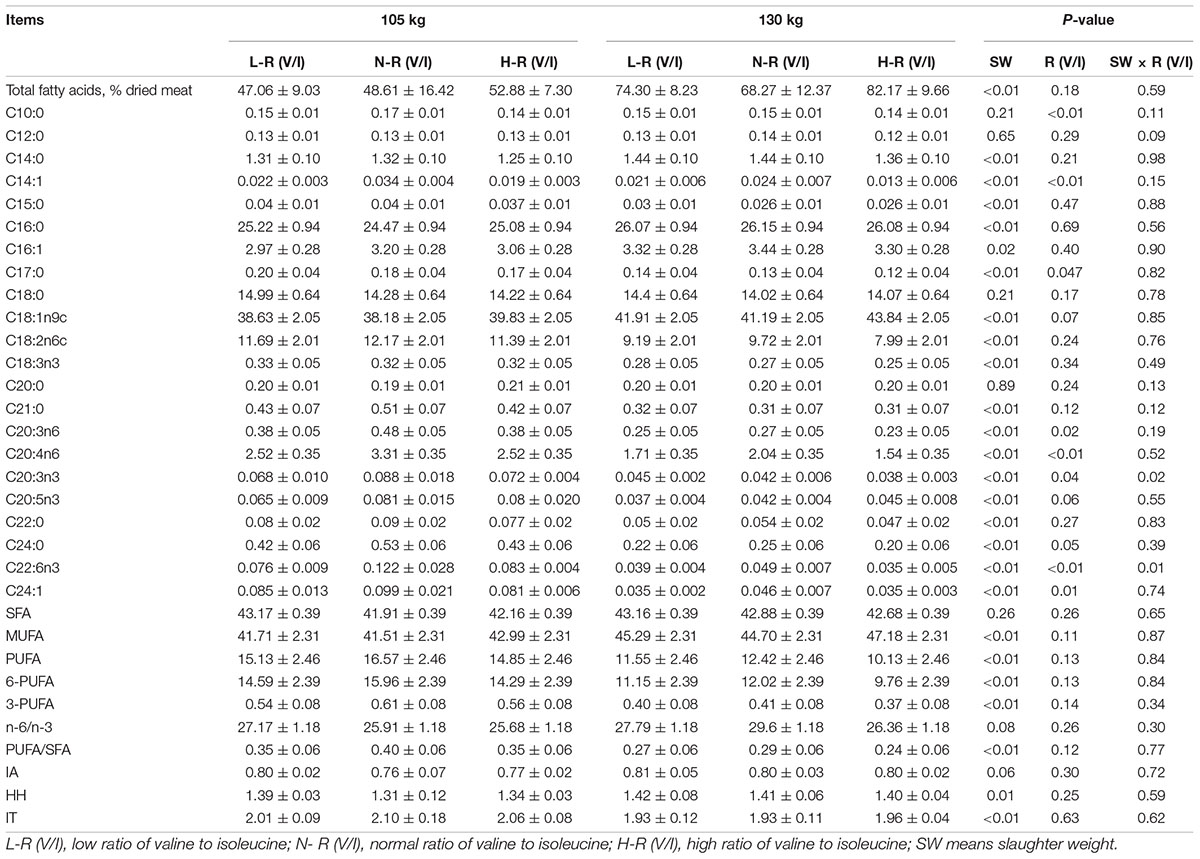
Table 7. Effect of dietary R (V/I) and slaughter weight on fatty acids composition (% of total fatty acid) of fresh meat in finishing pigs (n = 6).
Highest compositions of C14:1, C20:3n6, C20:4n6, C20:3n3, C24:0, C22:6n3 and C24:1 were observed in pigs fed N-R (V/I) diet compared with those in pigs fed H-R (V/I) and L-R (V/I) diet (P < 0.05). Meanwhile, L-R (V/I) and N-R (V/I) dietary treatments increased the composition of C10:0 and C17:0 compared with H-R (V/I) treatment. Interaction between R (V/I) and slaughter weight were observed for C20:3n3 and C22:6n3.
Discussion
Though valine and isoleucine are essential amino acids for pigs, they have been found to exert opposite impact on meat quality in finishing pigs (3, 4). In addition, slaughter weight is generally supposed to be a key factor affecting meat quality. Therefore, in the present study, we explore influences of slaughter weight, dietary ratio of valine to isoleucine and their interaction on carcass traits, meat quality and fresh meat nutrition values.
As expected, we observed that backfat thickness, fat-free lean meat index of carcass and IMF content increased while crude protein content of meat decreased as slaughter weight increased from 105 to 130 kg, which was in line with previous studies for crossbred Duroc × Landrace × Yorkshire pigs (11, 22–25). It is worth noting that the effect of slaughter weight on carcass traits and meat quality varies among pig breeds. For example, intramuscular fat content was not affected by slaughter weight in Pietrain pigs (26), Swiss Yorkshire barrows (27), crossbred Landrace × Yorkshire (28) and crossbred (Landrace × Yorkshire) × (Pietrain × Yorkshire) pigs (29), but increased with increased slaughter weight in crossbred Yorkshire × (Landrace × Pietrain) pigs (30) and Hampshire × Yorkshire × Duroc pigs (31). In general, carcass backfat thickness increases as slaughter weight increased among pig breeds (11, 22, 23, 25, 27, 29–32). We also found that meat color indices (a*45 min and b*45 min), drip loss and shear force of cooked meat increased as pig slaughter weight increased, while loin eye area of carcasses remained unchanged. The result of slaughter weight on meat color supported by previous studies, the M. longissimus thoracis of pigs slaughtered at heavy body weight was redder (higher a* value; P < 0.01) than that of pigs slaughtered at slight body weight in crossbred Duroc × Landrace × Yorkshire pigs (22, 23, 32), Yorkshire × (Landrace × Pietrain) pigs (30) and crossbred (Landrace × Yorkshire) × (Pietrain × Yorkshire) pigs (29). Interestingly, we notified that shear force value increased parallel to IMF content as pig slaughter weight increased. It suggested that shear force of cooked meat is not only correlated with IMF content especially in carcasses with significant gap of slaughter weights, but also correlated with other physiological characteristics of muscle, such as collagen structure, myofiber distribution and calpain enzyme activity as shown in previous studies (33, 34). It implied that optimal slaughter weight should be different for various meat quality indices.
According to previous studies (35), water distribution significantly affects water holding capacity (WHC) of fresh meat. The water distribution of fresh meat reflected by three fractions determined by NMR T2 relaxation analysis including bound water (T21), immobilized water (T22) and free water (T23). Besides, the free water reflects extra- myofibrillar water, which is mainly contributing to potential drip loss (36). Compared with immobilized water, the bound water only represented a minor part of the water present, and its change has limited impact on the WHC of meat. In the present study, the peak area ratio (%) of immobilized water (T22) was higher whereas the peak area ratio (%) of bound water (T21) was lower in pigs slaughtered at 130 kg BW than at 105 kg BW, as a consequence, the drip loss of fresh meat was higher in pigs slaughtered at 130 kg BW than pigs at 105 kg BW. And for the first time, we found that increasing slaughter weight reduces sarcomere length, which might also be partly responsible for the increased drip loss by the increased slaughter weight.
It is generally accepted that the fatty acid composition of intramuscular lipid in pork changed greatly with the increased slaughter weight (11). Consistently, we observed that the sum of MUFA increased but PUFA decreased as slaughter weight increased. Besides, we calculated health lipid indexes based on fatty acid composition of intramuscular lipid to evaluate the health quality of the muscle. The indices of atherogenicity (IA) and thrombogenicity (IT) have been introduced to characterize atherogenic and thrombogenic potential (20). The higher the ratio between hypocholesterolemic and hypercholesterolemic fatty acids (HH), the more the oil or fat is adequate to human nutrition (21). In our study, pigs slaughtered at 130 kg showed lower IT and higher HH, indicating that meat of pigs slaughtered at higher body weight may be beneficial to human health.
Compared with lighter pigs, heavier pigs exhibited higher IMF content and lower content of protein in the heavier pigs, which is in line with the previous study in crossbred Duroc × Landrace × Yorkshire pigs (23). However, in previous studies, it has been also observed that muscle protein content was not influenced with slaughter weight increased in crossbred Landrace × Yorkshire (28), crossbred (Landrace × Yorkshire) × (Pietrain × Yorkshire) pigs (29), and Swiss Yorkshire barrows (27). The inconsistency may be due to various pig breeds. Moreover, little attention was paid on the variation of amino acid profile caused by slaughter weight before. Here, we demonstrated for the first time that increased slaughter weight reduced most kinds of muscular total amino acid contents except for tryptophan and arginine, while increase muscular free amino acid contents, including lysine, tryptophan, leucine, isoleucine, valine, alanine, and arginine. The lower muscular total amino acids for the higher slaughter weight group could be attributed to its lower protein content and higher fat content in heavy pigs than those in light pigs.
The proportion of branched-chain amino acids could alter porcine fat mass (37). Particularly, backfat thickness was reduced in pigs fed diets supplemented with isoleucine compared with the control (38). Our previous studies have shown that dietary supplementation of isoleucine increase IMF content and water holding capacity of fresh meat in finishing pigs, while high level of dietary valine undermined water holding capacity (4). Consistently, in the present study, we observed that pigs fed H-R (V/I) diet had the weakest water holding capacity of fresh meat in all pigs. Water holding capacity are influenced by many factors, including pH, water distribution and muscle structure (4, 15, 39, 40). Here, we demonstrated that H-R (V/I) diet decreased ultimate pH value and sarcomere length but increased the proportion of free water (T23), consequently, undermined fresh meat WHC. Compared with pigs fed N-R (V/I) diet, pigs fed L-R(V/I) or H-R(V/I) diet had increased backfat thickness and IMF content, indicating that unbalanced dietary supply of valine and isoleucine (L-R(V/I) and H-R(V/I) diets) could lead to the obese in finishing pigs.
Although dietary R (V/I) exerted a secondary impact on muscular fatty acid profile compared with slaughter weight, we observed that balanced dietary valine and isoleucine supply (N-R (V/I) increased several PUFA, such as C20:3n6, C20:4n6, C20:3n3 and C22:6n3. In addition, we found that pigs received N-R (V/I) treatment increased muscular free amino acids that contribute to meat flavor, including the umami taste amino acids (aspartic acid and glutamic acid), sweet taste amino acids (glycine, alanine, valine), but did not affect bitter taste amino acids (methionine, isoleucine, tyrosine, phenylalanine, histidine, and arginine) compared with pigs received other two dietary treatments. Pigs fed the diet with N-R (V/I) had the highest nutritional value in terms of the muscular abundance of essential amino acids (lysine, methionine, and threonine) and non-essential amino acids (aspartic acid, cysteine, glycine, and serine).
We also observed significant interaction between dietary R(V/I) and slaughter weight on the last rib backfat thickness, fat-free lean index, and meat color. The effect of R(V/I) on these indicators weakened with the increase of slaughter weight, indicating that pigs with heavier slaughter weights are more resistant to the effected of dietary R(V/I) treatments.
Conclusion
Increased slaughter weight markedly favored meat color and IMF content but undermined water holding capacity of fresh meat and tenderness of cooked meat in finishing crossbred Duroc × Landrace × Yorkshire pigs. Pigs received N-R (V/I) diet improved carcass traits and meat flavor-contributing amino acids at the cost of reduction in IMF content and increase in shear force of cooked meat compared with the pigs fed L-R (V/I) and H-R(V/I) diets. In particular, the effects of dietary R(V/I) on carcass traits and meat color were influenced by slaughter weight.
Data Availability Statement
The original contributions presented in this study are included in the article/supplementary material, further inquiries can be directed to the corresponding author.
Ethics Statement
The animal study was reviewed and approved by the Institutional Animal Care and Use Committee of China Agricultural University.
Author Contributions
DX performed the animal experiments, analyzed the data, and wrote the manuscript. JY, XZ, and DX contributed to the experimental design and manuscript modification. YW was mainly responsible for the sample collection and data curation. EY, LH, LW, CM, and PZ carried out meat quality test. All authors approved the manuscript.
Funding
This work was supported by the National Key R&D Program of China (No. 2021YFF1000603) and the Major Project of National Key R&D Program of China (Grant No. 2018YFD0500402).
Conflict of Interest
The authors declare that the research was conducted in the absence of any commercial or financial relationships that could be construed as a potential conflict of interest.
Publisher’s Note
All claims expressed in this article are solely those of the authors and do not necessarily represent those of their affiliated organizations, or those of the publisher, the editors and the reviewers. Any product that may be evaluated in this article, or claim that may be made by its manufacturer, is not guaranteed or endorsed by the publisher.
Abbreviations
R(V/I), ratio of valine to isoleucine; BCAA, branched-chain amino acids; MUFA, monounsaturated fatty acids; BW, body weight; SID, standard ileal digestible; IMF, intramuscular fat; IA, atherogenic index; IT, thrombogenic index; HH, ratio between hypocholesterolemic and hypercholesterolemic fatty acids; PUFA, polyunsaturated fatty acids.
References
1. Duan Y, Duan Y, Li F, Li Y, Guo Q, Ji Y, et al. Effects of supplementation with branched-chain amino acids to low-protein diets on expression of genes related to lipid metabolism in skeletal muscle of growing pigs. Amino Acids. (2016) 48:2131–44. doi: 10.1007/s00726-016-2223-2
2. Duan Y, Guo Q, Wen C, Wang W, Li Y, Tan B, et al. Free amino acid profile and expression of genes implicated in protein metabolism in skeletal muscle of growing pigs fed low-protein diets supplemented with branched-chain amino acids. J Agric Food Chem. (2016) 64:9390–400. doi: 10.1021/acs.jafc.6b03966
3. Luo Y, Zhang X, Zhu Z, Jiao N, Qiu K, Yin J. Surplus dietary isoleucine intake enhanced monounsaturated fatty acid synthesis and fat accumulation in skeletal muscle of finishing pigs. J Anim Sci Biotechnol. (2018) 9:88. doi: 10.1186/s40104-018-0306-5
4. Xu DD, Wang YB, Jiao N, Qiu K, Zhang X, Wang LQ, et al. The coordination of dietary valine and isoleucine on water holding capacity, pH value and protein solubility of fresh meat in finishing pigs. Meat Sci. (2020) 163:108074. doi: 10.1016/j.meatsci.2020.108074
5. Nishimura T, Kato H. Taste of free amino acids and peptides. Food Rev Int. (1998) 4:175–94. doi: 10.1080/87559128809540828
6. Wood JD, Enser M, Fisher AV, Nute GR, Sheard PR, Richardson RI, et al. Fat deposition, fatty acid composition and meat quality: a review. Meat Sci. (2008) 78:343–58. doi: 10.1016/j.meatsci.2007.07.019
7. Kimball SR, Jefferson LS. Signaling pathways and molecular mechanisms through which branched-chain amino acids mediate translational control of protein synthesis. J Nutr. (2006) 136:227s–31s. doi: 10.1093/jn/136.1.227S
8. Wu F, Vierck KR, DeRouchey JM, O’Quinn TG, Tokach MD, Goodband RD, et al. A review of heavy weight market pigs: status of knowledge and future needs assessment. Transl Anim Sci. (2017) 1:1–15. doi: 10.2527/tas2016.0004
9. Gu Y, Schinckel AP, Forrest JC, Kuei CH, Watkins LE. Effects of ractopamine, genotype, and growth phase on finishing performance and carcass value in swine: I. Growth performance and carcass merit. J Anim Sci. (1991) 69:2685–93. doi: 10.2527/1991.6972685x
10. Van den Broeke A, Leen F, Aluwe M, Van Meensel J, Millet S. The effect of sex and slaughter weight on performance, carcass quality and gross margin, assessed on three commercial pig farms. Animal. (2020) 14:1546–54. doi: 10.1017/s1751731119003033
11. Apple JK, Maxwell CV, Galloway DL, Hutchison S, Hamilton CR. Interactive effects of dietary fat source and slaughter weight in growing-finishing swine: I. Growth performance and longissimus muscle fatty acid composition. J Anim Sci. (2009) 87:1407–22. doi: 10.2527/jas.2008-1453
12. Nutrient Requirements of Swine [NRC]. Nutrient Requirements of Swine. 10th rev. ed. Washington, DC: Natl Acad Press (2012).
13. National Pork Producers Council [NPPC]. Fat-Free Lean Index. Des Moines, IA: National Pork Producers Council (1994).
14. Association of Official Analytial Chemists [AOAC]. Official Methods of Analysis. 18th ed. Gaithersburg, MD: Association of Official Analytial Chemists (2008).
15. Bertram HC, Andersen RH, Andersen HJ. Development in myofibrillar water distribution of two pork qualities during 10-month freezer storage. Meat Sci. (2007) 75:128–33. doi: 10.1016/j.meatsci.2006.06.020
16. Li YJ, Li JL, Zhang L, Gao F, Zhou GH. Effects of dietary starch types on growth performance, meat quality and myofibre type of finishing pigs. Meat Sci. (2017) 131:60–7. doi: 10.1016/j.meatsci.2017.04.237
17. Xie Y, Chen B, Guo J, Nie W, Zhou H, Li PJ, et al. Effects of low voltage electrostatic field on the microstructural damage and protein structural changes in prepared beef steak during the freezing process. Meat Sci. (2021) 179:108527. doi: 10.1016/j.meatsci.2021.108527
18. Yin BJ, Li TT, Zhang SR, Li Z, He PL. Sensitive analysis of 33 free amino acids in serum, milk, and muscle by ultra-high performance liquid chromatography-quadrupole-orbitrap high resolution mass spectrometry. Food Anal Method. (2016) 9:2814–23. doi: 10.1007/s12161-016-0463-0
19. Childs CE, Romeu-Nadal M, Burdge GC, Calder PC. The polyunsaturated fatty acid composition of hepatic and plasma lipids differ by both sex and dietary fat intake in rats. J Nutr. (2010) 140:245–50. doi: 10.3945/jn.109.115691
20. Ulbricht TLV, Southgate DAT. Coronary heart-disease - 7 dietary factors. Lancet. (1991) 338:985–92. doi: 10.1016/0140-6736(91)91846-m
21. Santos-Silva J, Bessa RJB, Santos-Silva F. Effect of genotype, feeding system and slaughter weight on the quality of light lambs II. Fatty acid composition of meat. Livest Prod Sci. (2002) 77:187–94. doi: 10.1016/s0301-6226(02)00059-3
22. Park B, Lee CY. Feasibility of increasing the slaughter weight of finishing pigs. J Anim Sci Technol. (2011) 53:211–22. doi: 10.5187/JAST.2011.53.3.211
23. Ba HV, Seo HW, Seong PN, Cho SH, Kang SM, Kim YS, et al. Live weights at slaughter significantly affect the meat quality and flavor components of pork meat. Anim Sci J. (2019) 90:667–79. doi: 10.1111/asj.13187
24. Latorre MA, Ripoll G, Garcia-Belenguer E, Arino L. The effect of gender and slaughter weight on loin and fat characteristics of pigs intended for Teruel dry-cured ham production. Span J Agric Res. (2009) 7:407–16. doi: 10.5424/sjar/2009072-1648
25. Choi YM, Oh HK. Carcass performance, muscle fiber, meat quality, and sensory quality characteristics of crossbred pigs with different live weights. Korean J Food Sci Anim Resour. (2016) 36:389–96. doi: 10.5851/kosfa.2016.36.3.389
26. Raj S, Skiba G, Weremko D, Fandrejewski H, Migdał W, Borowiec F, et al. The relationship between the chemical composition of the carcass and the fatty acid composition of intramuscular fat and backfat of several pig breeds slaughtered at different weights. Meat Sci. (2010) 86:324–30. doi: 10.1016/j.meatsci.2010.04.037
27. Bee G, Calderini M, Biolley C, Guex G, Herzog W, Lindemann MD. Changes in the histochemical properties and meat quality traits of porcine muscles during the growing-finishing period as affected by feed restriction, slaughter age, or slaughter weight. J Anim Sci. (2007) 85:1030–45. doi: 10.2527/jas.2006-496
28. Povod M, Mykhalko O, Kyselov O, Opara V, Andreychuk V, Samokhina Y. Effects of various pre-slaughter weights on the physico-chemical qualities of pig meat. J Adv Vet Anim Res. (2021) 8:521–33. doi: 10.5455/javar.2021.h542
29. Latorre MA, Lázaro R, Valencia DG, Medel P, Mateos GG. The effects of gender and slaughter weight on the growth performance, carcass traits, and meat quality characteristics of heavy pigs. J Anim Sci. (2004) 82:526–33. doi: 10.2527/2004.822526x
30. Corino C, Musella M, Mourot J. Influence of extruded linseed on growth, carcass composition, and meat quality of slaughtered pigs at one hundred ten and one hundred sixty kilograms of liveweight. J Anim Sci. (2008) 86:1850–60. doi: 10.2527/jas.2007-0155
31. Cisneros F, Ellis M, McKeith FK, McCaw J, Fernando RL. Influence of slaughter weight on growth and carcass characteristics, commercial cutting and curing yields, and meat quality of barrows and gilts from two genotypes. J Anim Sci. (1996) 74:925–33. doi: 10.2527/1996.745925x
32. Latorre MA, García-Belenguer E, Ariño L. The effects of sex and slaughter weight on growth performance and carcass traits of pigs intended for dry-cured ham from Teruel (Spain). J Anim Sci. (2008) 86:1933–42. doi: 10.2527/jas.2007-0764
33. Beattie RJ, Bell SJ, Farmer LJ, Moss BW, Patterson D. Preliminary investigation of the application of Raman spectroscopy to the prediction of the sensory quality of beef silverside. Meat Sci. (2004) 66:903–13. doi: 10.1016/j.meatsci.2003.08.012
34. Nair MN, Canto A, Rentfrow G, Suman SP. Muscle-specific effect of aging on beef tenderness. LWT Food Sci Technol. (2019) 100:250–2. doi: 10.1016/j.lwt.2018.10.038
35. Bertram HC, Andersen HJ. NMR and the water-holding issue of pork. J Anim Breed Genet. (2007) 124(Suppl. 1):35–42. doi: 10.1111/j.1439-0388.2007.00685.x
36. Bertram HC, Dønstrup S, Karlsson AH, Andersen HJ. Continuous distribution analysis of T(2) relaxation in meat-an approach in the determination of water-holding capacity. Meat Sci. (2002) 60:279–85. doi: 10.1016/s0309-1740(01)00134-6
37. Zhang LY, Li FN, Guo QP, Duan YH, Wang WL, Yang YH, et al. Different proportions of Branched-Chain amino acids modulate lipid metabolism in a finishing pig model. J Agr Food Chem. (2021) 69:7037–48. doi: 10.1021/acs.jafc.1c02001
38. Figueroa JL, Lewis AJ, Miller PS, Fischer RL, Diedrichsen RM. Growth, carcass traits, and plasma amino acid concentrations of gilts fed low-protein diets supplemented with amino acids including histidine, isoleucine, and valine. J Anim Sci. (2003) 81:1529–37. doi: 10.2527/2003.8161529x
39. Choi YM, Lee SH, Choe JH, Rhee MS, Lee SK, Joo ST, et al. Protein solubility is related to myosin isoforms, muscle fiber types, meat quality traits, and postmortem protein changes in porcine longissimus dorsi muscle. Livest Sci. (2010) 127:183–91. doi: 10.1016/j.livsci.2009.09.009
Keywords: dietary ratio of valine to isoleucine, slaughter weight, water holding capacity, fatty acid composition, amino acid profile
Citation: Xu D, Wang Y, Zhang X, Yan E, He L, Wang L, Ma C, Zhang P and Yin J (2022) Dietary Valine/Isoleucine Ratio Impact Carcass Characteristics, Meat Edible Quality and Nutritional Values in Finishing Crossbred Duroc × Landrace × Yorkshire Pigs With Different Slaughter Weights. Front. Nutr. 9:899871. doi: 10.3389/fnut.2022.899871
Received: 19 March 2022; Accepted: 17 June 2022;
Published: 11 July 2022.
Edited by:
Jian Zhong, Shanghai Jiao Tong University, ChinaReviewed by:
Hengjia Ni, Institute of Subtropical Agriculture (CAS), ChinaMarta Laranjo, University of Évora, Portugal
Copyright © 2022 Xu, Wang, Zhang, Yan, He, Wang, Ma, Zhang and Yin. This is an open-access article distributed under the terms of the Creative Commons Attribution License (CC BY). The use, distribution or reproduction in other forums is permitted, provided the original author(s) and the copyright owner(s) are credited and that the original publication in this journal is cited, in accordance with accepted academic practice. No use, distribution or reproduction is permitted which does not comply with these terms.
*Correspondence: Jingdong Yin, eWluamRAY2F1LmVkdS5jbg==
†These authors have contributed equally to this work
 Doudou Xu
Doudou Xu Yubo Wang
Yubo Wang Xin Zhang
Xin Zhang Enfa Yan
Enfa Yan Linjuan He
Linjuan He Lu Wang
Lu Wang Chenghong Ma
Chenghong Ma Pengguang Zhang
Pengguang Zhang Jingdong Yin
Jingdong Yin